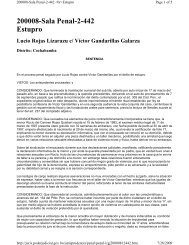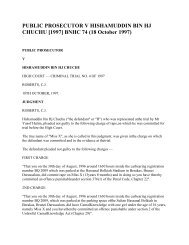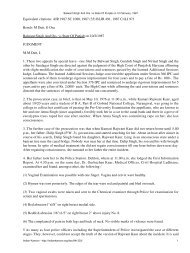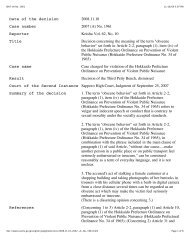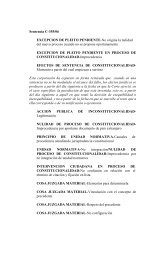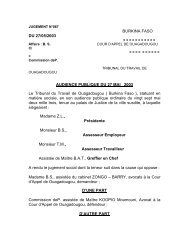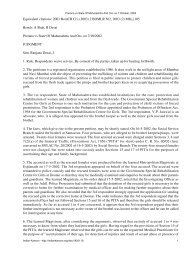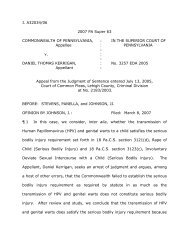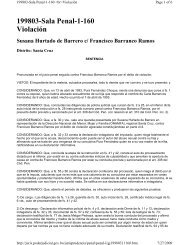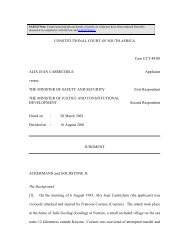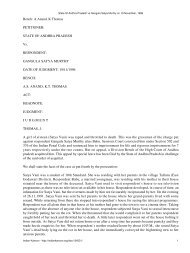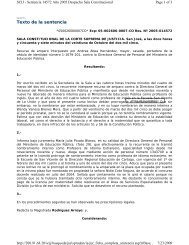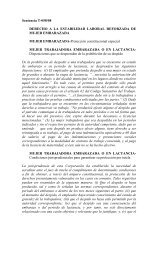P. Rathinam v. Union of India - Cornell University
P. Rathinam v. Union of India - Cornell University
P. Rathinam v. Union of India - Cornell University
- No tags were found...
Create successful ePaper yourself
Turn your PDF publications into a flip-book with our unique Google optimized e-Paper software.
withdrawal <strong>of</strong> his respirator did not tantamount to suicide the same was rather an exercise <strong>of</strong> his constitutionaland common law right to discontinue unwanted medical treatment. This was the view taken by the majority.One <strong>of</strong> the Judges expressed a dissenting view.14. A comment has been made on the aforesaid decision [at pp. 829 to 838 <strong>of</strong> Suffolk <strong>University</strong> Law Review,Vol. 25 (1991)] by stating that the distinction made by the majority between suicide and euthanasia because <strong>of</strong>differences in motive and mental attitude, is not tenable and the commentator referred to the dissentingopinion in which it was observed that the patient was in fact requesting the court to sanction affirmative actwhich was entirely consistent with the court's definition <strong>of</strong> suicide, inasmuch as the majority had definedsuicide as "an act or instance <strong>of</strong> taking one's own life voluntarily and intentionally; the deliberate andintentional destruction <strong>of</strong> his own life by a person <strong>of</strong> years <strong>of</strong> discretion and <strong>of</strong> sound mind; one that commitsor attempts his self-murder". (This was indeed the definition given in Webster's Third New InternationalDictionary, 1968.)15. We may now note the reasons given by the Bombay High Court in Shripati case2 for striking down thesection as violation <strong>of</strong> Article 21. These reasons are basically three: (1) Article 21 has conferred a positiveright to live which carries with it the negative right not to live. In this connection it has been first stated thatthe fundamental rights are to be read together as held in R. C. Cooper v. <strong>Union</strong> <strong>of</strong> <strong>India</strong>6. Mention was thenmade <strong>of</strong> freedom <strong>of</strong> speech and expression, as to which it was observed that the same includes freedom not tospeak and to remain silent. Similarly, about the freedom <strong>of</strong> business and occupation, it was stated that itincludes freedom not to do business. (2) Notice was then taken <strong>of</strong> the various causes which lead people tocommit suicide. These being mental diseases and imbalances, unbearable physical ailments, affliction bysocially-dreaded diseases, decrepit physical condition disabling the person from taking normal care <strong>of</strong> hisbody and performing the normal chores, the loss <strong>of</strong> all senses or <strong>of</strong> desire for the pleasures <strong>of</strong> any <strong>of</strong> thesenses, extremely cruel or unbearable conditions <strong>of</strong> life making it painful to live, a sense <strong>of</strong> shame or disgraceor a need to defend one's honour or a sheer loss <strong>of</strong> interest in life or disenchantment with it, or a sense <strong>of</strong>fulfilment <strong>of</strong> the purpose for which one was born with nothing more left to do or to be achieved and a genuineurge to quit the world at the proper moment. (3) The Bench thereafter stated that in our country differentforms <strong>of</strong> suicide are known. These being: Johars (mass suicides or self-immolation) <strong>of</strong> ladies from the royalhouses to avoid being dishonoured by the enemies; Sati (self-immolation by the widow on the burning pyre <strong>of</strong>her deceased husband); Samadhi (termination <strong>of</strong> one's life by self-restraint on breathing); Prayopaveshan(starving unto death); and Atmarpana (self-sacrifice). It was also observed that the saints and savants, social,political and religious leaders have immolated themselves in the past and do so even today by one method orthe other and society has not only6 (1970) 2 SCC 298 : AIR 1970 SC 1318405P.<strong>Rathinam</strong> vs <strong>Union</strong> Of <strong>India</strong> on 26 April, 1994not disapproved <strong>of</strong> the practice but has eulogised and commemorated the practitioners. It may be pointed outthat the Bench made a distinction between "suicide" and "mercy- killing"; so also, between suicide and aidingor abetting the same.16. The Bombay High Court held Section 309 as violation <strong>of</strong> Article 14 also mainly because <strong>of</strong> two reasons.First, which act or acts in series <strong>of</strong> acts will constitute attempt to suicide, where to draw the line, is not knownsome attempts may be serious while others non-serious. It was stated that in fact philosophers, moralists andsociologists were not agreed upon what constituted suicide. The want <strong>of</strong> plausible definition or evenguidelines, made Section 309 arbitrary as per the learned Judges. Another reason given was that Section 309treats all attempts to commit suicide by the same measure without referring to the circumstances in whichattempts are made.<strong>India</strong>n Kanoon - http://indiankanoon.org/doc/542988/ 4



